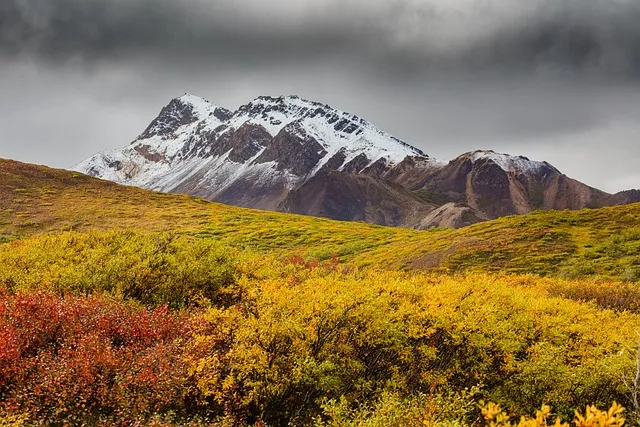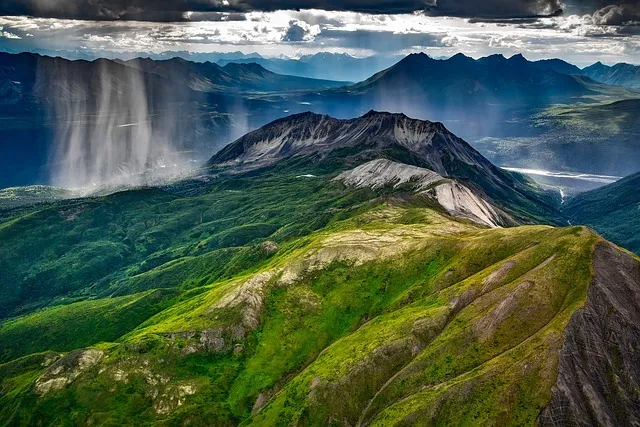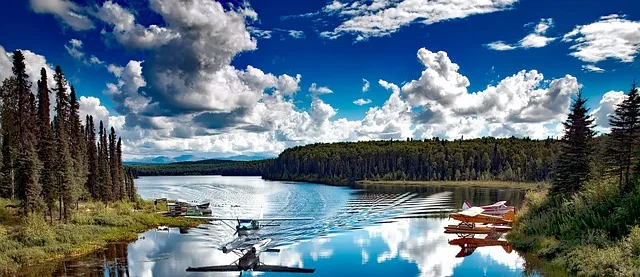Alaska boasts a rich ecosystem with diverse habitats ranging from rainforests to tundra, each supporting unique wildlife species with adaptations suited to their environments. The state's coastal areas are home to marine life like orcas and salmon, while the interior and Arctic regions host land species such as caribou, moose, and snowy owls. Alaska's climate features stark contrasts between its maritime coastal regions and its interior's subarctic conditions, influenced by weather patterns like the Aleutian Low. These climatic differences are crucial for the geographical and ecological diversity found in the state. Throughout the year, Alaska offers outdoor activities tailored to each season, from winter sports under the Northern Lights to summer kayaking and wildlife viewing. Conservation efforts, including the establishment of protected areas like the Arctic National Wildlife Refuge and the Gates of the Arctic National Park, are vital for preserving these ecosystems, supporting biodiversity, and studying the effects of climate change. These conservation measures also respect the traditional practices of indigenous peoples and honor the natural legacy of Alaska's landscapes for future generations. The Wilderness Act of 1964 has been instrumental in protecting vast wilderness areas within the state.
Embark on a journey through the vast and pristine wilds of Alaska, where nature’s grandeur unfolds in a spectacle of untamed beauty. This article delves into the rich tapestry of Alaska’s ecosystems, showcasing their remarkable diversity and the myriad of wildlife that thrives within these habitats. It explores the unique climate and weather patterns that sculpt the breathtaking landscape, revealing how these elements contribute to Alaska’s distinctive character. Adventure enthusiasts will find a treasure trove of outdoor activities tailored for every season, offering unparalleled opportunities to immerse oneself in the wilderness. Furthermore, the article highlights the critical preservation efforts and protected areas that safeguard this natural splendor for future generations to discover and cherish. Join us as we shed light on the resilience and beauty of Northern Alaska’s untamed landscapes.
- Alaskan Ecosystems: Diverse Habitats and Resident Wildlife
- Unique Climate and Weather Patterns Shaping the Landscape
- Outdoor Activities for Every Season in Alaska's Wilderness
- Preservation Efforts and Protected Areas in Northern Alaska
Alaskan Ecosystems: Diverse Habitats and Resident Wildlife

Alaska’s ecosystems are a mosaic of diverse habitats that support an array of resident wildlife, each playing a critical role in maintaining ecological balance. The state’s landscapes range from the dense rainforests of Southeast Alaska to the tundra and taiga of the North Slope. These environments host unique species adapted to their surroundings, showcasing remarkable evolutionary processes. For instance, the coastal waters are home to orcas, humpback whales, and sea otters, each with distinct behaviors and ecological niches. Inland, rivers teem with salmon, which in turn provide sustenance for bears and eagles. The interior of Alaska features vast tracts of boreal forest where caribou roam and moose forage. To the north, the Arctic tundra presents a different set of challenges and opportunities for species like the snowy owl and the musk ox. These habitats are not only critical for wildlife survival but also offer invaluable insights into Earth’s natural processes and climate history. The preservation of these ecosystems is essential for their continued health and the myriad species that depend on them, highlighting the importance of conservation efforts in this vast and varied landscape.
Unique Climate and Weather Patterns Shaping the Landscape

Alaska’s vast wilderness is shaped by a complex tapestry of climate and weather patterns that are both extreme and diverse. The state’s coastal regions experience milder temperatures with higher precipitation, while its interior faces harsh, subarctic conditions with significant seasonal variations. The North Pacific High exerts a dominant influence on the region, steering storm tracks and moderating temperatures along the coast. This high-pressure system is responsible for the predominantly maritime weather patterns that bring moist air from the Pacific Ocean, which can result in abundant rainfall and contribute to the lushness of the coastal ecosystems. The Aleutian Low, an area of low pressure located off the coast of Alaska, interacts with the North Pacific High to create complex atmospheric dynamics, including the path of the jet stream, which can bring both mild and stormy weather to the region.
Further inland, the influence of the Arctic air masses becomes more pronounced. The cold, dry air from the Arctic descends into the interior, leading to significant temperature contrasts between summer and winter. During the long, dark winters, frost heaves, permafrost thawing, and ice-related phenomena such as ice fog shape the landscape. Conversely, the brief but intense summers are characterized by rapid snowmelt and river swelling, which carve the land and sustain a surprisingly diverse array of flora and fauna. These climate patterns not only sculpt Alaska’s geography but also influence its unique ecosystems, creating a dynamic environment that is both challenging and awe-inspiring for those who venture into this northern expanse.
Outdoor Activities for Every Season in Alaska's Wilderness

Alaska’s wilderness offers a mosaic of outdoor activities tailored to each season, inviting adventurers and nature enthusiasts to experience its untamed beauty. During the winter months, visitors can partake in dog sledding, skiing, or snowmobiling across the pristine, snow-covered landscapes. The aurora borealis, or Northern Lights, often puts on a dazzling display, adding a touch of magic to the cold season’s activities. As spring unfolds, the focus shifts to ice fishing and snow machining, with the opportunity to traverse frozen rivers and lakes before they thaw.
The onset of summer transforms Alaska into an explorer’s paradise, where kayaking, hiking, and wildlife observation become the main attractions. The long daylight hours provide ample time to navigate through glacial fjords or trek along the rugged coastlines dotted with abundant wildlife. The fall season offers a unique perspective on Alaska’s natural splendor, with activities like bear watching and fishing for salmon in crystal-clear rivers before the cycle begins anew. Each season brings its own set of experiences, ensuring that every visit to Alaska’s wilderness is distinct and unforgettable.
Preservation Efforts and Protected Areas in Northern Alaska

In Northern Alaska, preservation efforts have been pivotal in safeguarding the region’s pristine landscapes and diverse ecosystems. The establishment of protected areas such as the Arctic National Wildlife Refuge and the Gates of the Arctic National Park and Preserve has been instrumental in conserving habitats that are home to a myriad of wildlife species, including caribou, grizzly bears, and migratory birds. These sanctuaries not only protect the natural beauty and ecological integrity but also serve as critical research sites for understanding the Arctic environment’s resilience and adaptation to climate change. The collaborative efforts between local communities, environmental organizations, and government agencies ensure that these areas are managed sustainably, balancing conservation goals with the traditional ways of life for indigenous peoples who have long stewarded these lands.
Furthermore, the use of wilderness as a benchmark for conservation has been central to the preservation strategy in Northern Alaska. The Wilderness Act of 1964 and subsequent legislation have led to the designation of vast swaths of land as wilderness areas, where natural processes are left unimpeded by permanent human habitation or exploitation. These designated areas offer a refuge for wildlife and plants, allowing them to thrive without the pressures of industrial development. The protection of these landscapes also preserves the cultural heritage of indigenous peoples, who have an intimate relationship with the land, relying on its resources in a sustainable manner. The ongoing commitment to protecting Northern Alaska’s wilderness is a testament to the collective recognition of its ecological and cultural significance, ensuring that it remains an integral part of the Earth’s natural heritage for future generations.
Alaska’s wilderness stands as a testament to Earth’s natural grandeur, with its diverse ecosystems, unique climate, and bountiful outdoor activities offering a year-round tapestry of experiences. The commitment to preservation through protected areas ensures that the splendor of Northern Alaska endures, safeguarding the habitats of its resident wildlife and the distinctive landscapes shaped by elemental weather patterns. As visitors engage with this pristine environment, they are reminded of the delicate balance required for such ecosystems to thrive, emphasizing the importance of stewardship and conservation in maintaining the integrity of these remarkable northern lands.
